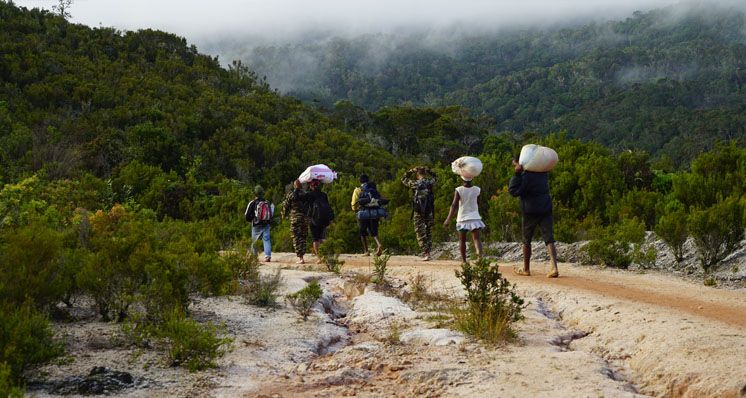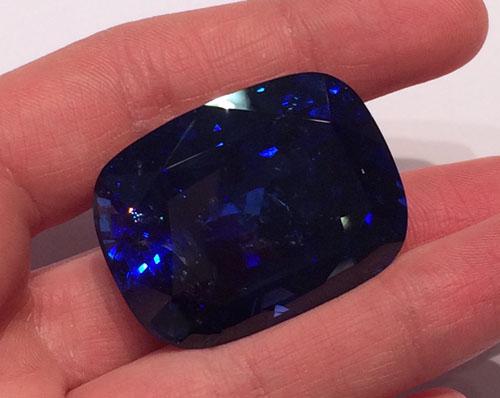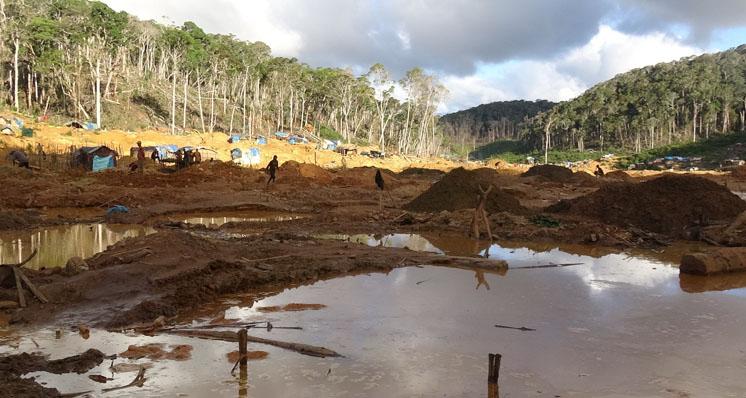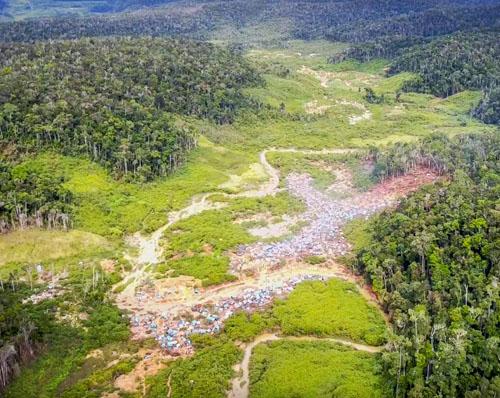
In the last 12 months, an exceptional sapphire rush in eastern Madagascar saw thousands of people searching for precious treasure in one of the poorest places on earth. Rosey Perkins GG, an independent gemmologist based in London, shares this report from two visits to the island nation.
A sapphire rush that started in September 2016 has produced world class sapphires close to the village of Bemainty, in the wet forest of eastern Madagascar has reached upwards of 45,000 people. The mine site was in an area called Corridor Ankeliheny-Zahamena (CAZ), which is designated for conservation and managed by Conservation International on behalf of the Government of Madagascar.
I gained access to the mines near the village of Bermainty in October 2016 and May 2017 and was able to capture the lifecycle of the mines that has become known as ‘Tananarive Carrier’ (18°00’00″N 48°67’83”).
‘Tananarive’, which is the capital city of Madagascar, refers to its size and ‘carriere’ is Malagasy for ‘mine’. It lies 135km NE of the capital and is accessed via the nearest town of Ambatondrazaka. From here a motorbike can be taken to the trailhead at Ansevabe. On 21 October 2016, the President of Madagascar had declared the mining activity illegal because it was inside CAZ. I arrived at the mine the following day. There was a sense of urgency and camaraderie as the miners anticipated imminent government intervention.

1: 100ct sapphire from Bemainty Mines.
The gendarme were present at the site to keep peace and monitor the mining activity. The mine was highly productive and in Ambatondrazaka, I was shown high-quality blue sapphire up to 50g, as well as desirably-coloured pink-orange sapphires, reportedly mined at Bermainty (1). However, in February, the Swiss Gemmological Institute (SSEF) issues a trade alert with the warning that sapphires from these mines were being misreported as Kashmiri (Krzemnicki, 2017). A preliminary study of sapphires from this deposit indicated that the origin of these sapphires would prove challenging for laboratories and that more in-depth analysis was needed (Pardieu, 2017). For this reason, Lotus Gemology needed samples and so it was thanks to them and Association Française Gemmologie that I returned on May 6, 2017.
At 5am, I started climbing the path towards the mine and 10 hours later, we reached the valley that had heaved tens of thousands of people in October. It was a wide valley carved with pits but in May 2017 only about 500 miners remained. The southern end had been almost abandoned and work was concentrated in the more productive central and northern areas, where old pits two to three metres deep were being reworked. Miners had left due to illness, lack of funding or to return to their previous jobs. In the nearby valleys that had been explored, many groups hadn’t found a stone for months. (2&3).

2. Tananrive Carrier facing North in October 2016.

3: Tananrive Carrier in May 2017. Image by Rosey Perkins.
However, the mining area had been a valuable source of income during the months that the local population had waited for the rains, which came later than usual. They arrived as miners, porters or cooks to feed the growing community. Soon the exploration had moved into the adjoining valleys, which were named Milliard 1-4. In May, shreds of blue tarpaulin attached to the top of poles marked abandoned claims and only the skeletons of abandoned huts remained. Morale was low in the valleys, but a few months earlier they had been a source of hope (4).
At Tananarive Carrier families lived in two story huts and many had tents on the first floor with shops beneath. These were stocked with beer, local rum, vegetables and plenty of meat. There was a hut for gambling, a cinema with a projector and a board of power sockets offering electricity to charge mobile phones. There were two churches and a mosque but still no school and no sanitation. A doctor had visited for the month of November but the gendarme (law enforcement) said another was needed.

4: Abandoned section of Milliard 3. ‘Milliard is French for ‘Billion’ and a billion ariary (the currency of Madagascar) worth of stones – approximately £300,000 – had been found in each.
Trading was open and the gendarme was relaxed. At the start of the rush there were many independent ‘cooperatives’ but in May 2017 most were from other mining areas in Madagascar, such as Diego Suarez, Sakahara and Fort Dauphin. Mining activity was mainly sponsored by businessmen from the major cities. They financed another ‘sponsor’ who stayed at the mine and hired men in groups, providing food and equipment in exchange for first refusal on the stones they found. At Tananarive Carrier I met an independent sponsor who employed 16 miners, eight security guards and a woman who cooked their meals. His miners formed two groups and shared the use of a motor pump. He supplied the equipment for digging, the fuel for their motor and food for the men. He said he spent approximately $35 per week on rice and meat for the miners and expected to sell a sapphire with 30%-40% profit.
Ambodipaiso and Sahambato were two mining communities that had sprung up by miners leaving Tananarive Carrier (5). They had stopped at a river, camped and dug a test pit or panned for gold and found sapphires. Movement between them was fluid and, as a large sapphire was found at one site, the response was an influx of people (6).

5: Ambodipaiso on May 6th 2017. Image courtesy of Zanaky Ny Lalana.
As miners continue to explore this gem-rich earth of eastern Madagascar, there may be a great many more rushes in the area (Pardieu 2017). While the Government of Madagascar has declared the mining activity illegal, they have not brought it to a halt. The media’s coverage of this story has not portrayed the gem industry favourably and, as mining continues, pressure will be on the gem and jewellery industry to respond.
Impact assessments are being carried out by independent consultancies on behalf of businesses sourcing gemstones in Madagascar and the response is likely to be rehabilitation programmes in areas of land damaged by mining activity. A collective effort to support conservation would help sustain Madagascar’s biodiversity and also demonstrate the gem industry’s commitment to responsible sourcing.

6: Sapphires from Sahambato which resulted in an influx of people to the area.
Acknowledgements: Permission to enter CAZ was given by the Prefecture D’Ambatondrazaka, Direction Regionale de L’Environment De L’Ecologie et de Forets and the Bureau du Cadastre Minier de Madagascar. The gendarme permitted our team four days inside the areas and gave us two policemen as security guards. Thank you to Institute Gemmologie de Madagascar, Association Francaise de Gemmologie, Lotus Gemology and Vincent Pardieu for their time and support.
Gem-A members can log in to read the full article Gems&Jewellery Autumn 2017 / Volume 26 / No. 3
Interested in finding out more about gemmology? Sign-up to one of Gem-A’s courses or workshops.
If you would like to subscribe to Gems&Jewellery and The Journal of Gemmology please visit Membership.
Cover image: The team walking from Ansevabe towards the miners. Two gendarmes (local police) joined them as a security measure. In October 2016, Rosey had counted 1,000 people travelling towards the mine. In May 2017 we passed less than 50. All images by Rosey Perkins, unless otherwise stated.
{module Blog Articles Widget}


